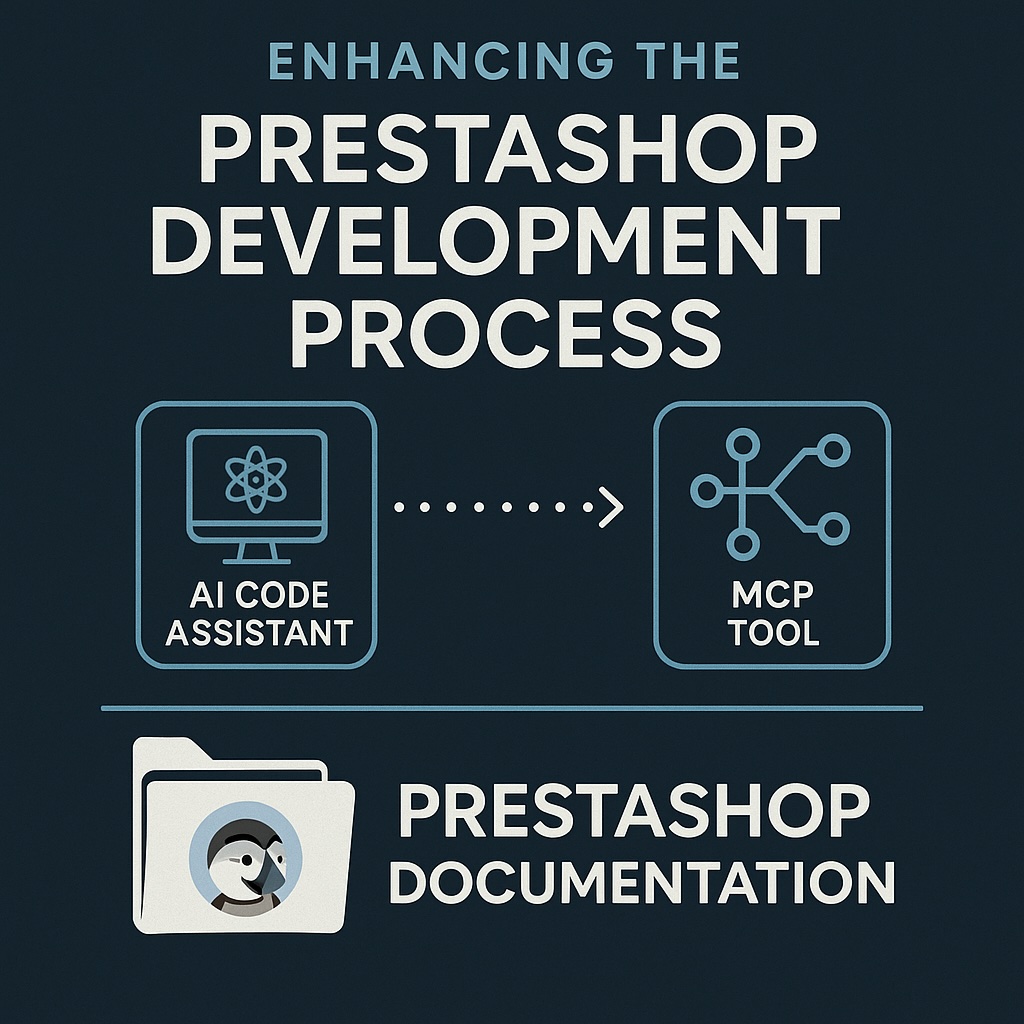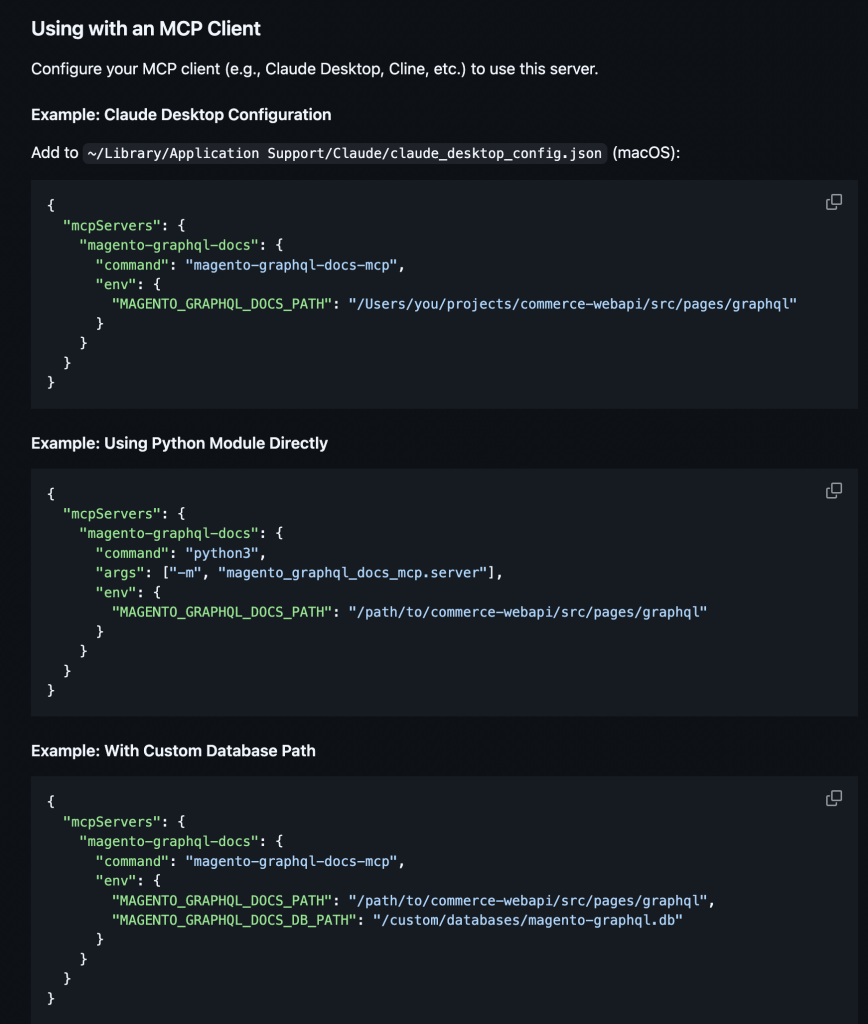For a PrestaShop developer, the hard part is rarely “how do I write this PHP class?” – it’s “what’s the right hook?”, “where does this piece of UI come from?”, “which API endpoint actually governs this behavior?”, and “which of the 600+ docs did I see that in last month?”.
The prestashop-mcp project answers exactly that pain point by turning the entire PrestaShop documentation set into a fast, local, AI-native knowledge server. (GitHub)
Below is a deep dive into how this actually changes your day-to-day development process as a PrestaShop dev.
1. The reality of PrestaShop development today
PrestaShop is not a small codebase:
- 647+ hooks, split between display/action, front office/back office, core/module/theme, etc. (GitHub)
- Dozens of architecture concepts: CQRS, domain commands/queries, form and grid components, services…
- Theme layer (Smarty/Twig), webservice & Admin APIs, module boilerplates, contribution guidelines, deployment docs, and so on.
The official docs are good, but:
- They’re web-only.
- Search is web search + scrolling through long pages.
- You constantly context-switch: IDE → browser → docs → back to IDE.
- AI tools (Claude, Cursor, VS Code chat, etc.) don’t “really know” PrestaShop unless you paste docs manually every time.
The result: a lot of time is spent recalling “what is the correct hook for this area?”, “where are the domain commands documented?”, or “is this old webservice example still canonical?”.
prestashop-mcp is built to make that friction disappear.
2. What prestashop-mcp actually is
At a high level, prestashop-mcp is a Model Context Protocol (MCP) server specialized for PrestaShop.
It:
- Indexes 1,095+ markdown docs from the official PrestaShop documentation repo – hooks, guides, components, APIs, tutorials, references, FAQs. (GitHub)
- Stores them in a SQLite FTS5 full-text index, tuned for fast queries (<50ms). (GitHub)
- Exposes that index through MCP tools that AI assistants (Claude, Cursor, VS Code MCP, etc.) can call directly. (GitHub)
So instead of you searching the docs website, your AI assistant can:
- Search documents by type, category, and content.
- Fetch the full content of a specific doc.
- Query hooks by name or by semantic purpose (“hooks related to products”).
- Get stats and lists to explore the surface area of the platform. (GitHub)
Crucially: it is offline-first and local. Once indexed, everything runs from your machine; no network, no SaaS dependency, just a small SQLite DB under ~/.mcp/prestashop-docs/. (GitHub)
3. Integrating into the tools you already use
Out of the box, prestashop-mcp plugs into:
- Claude Desktop / Claude Code via
claude_desktop_config.jsonor.mcp.jsonwith a simple"command": "prestashop-mcp"or wrapper script. (GitHub) - VS Code via
.mcp.jsonand the MCP extension. - Cursor via its MCP servers settings.
- Plain stdio or HTTP/SSE transports if you want to host it yourself. (GitHub)
Practically, that means:
You open your PrestaShop project in VS Code or Cursor, talk to your AI assistant, and it has first-class access to the entire PrestaShop doc set.
No more copying doc URLs into prompts. No more “I think I saw this in the hooks reference page but don’t remember where”.
4. How it changes the development workflow (concrete scenarios)
Let’s go through typical PrestaShop tasks and see the before/after.
4.1 Finding the right hooks
Before
You want to inject content on the product page, or run logic when a product is updated. You:
- Google “Prestashop hooks product page”.
- Open the hooks reference page.
- Scroll, search, guess between
displayHeader,displayProductExtraContent,actionProductSave, etc. - Hope the doc you’re reading is current for your PrestaShop version.
With prestashop-mcp
You ask your AI assistant (which now has hook tools like search_prestashop_hooks and get_prestashop_hook available): (GitHub)
“Find all hooks related to products in the front office, and explain which ones are best for adding a block below the product description.”
The MCP server:
- Searches hooks with
hook_type/originfilters. - Returns a list of hooks with metadata (location, type, usage).
- The assistant can then:
- Recommend the most appropriate hook for your use case.
- Show you the official doc snippet for that hook.
- Generate example module code that hooks into it.
This dramatically cuts down “hook roulette” and encourages more consistent, idiomatic usage of the platform.
4.2 Module development and refactoring
Before
Writing a new module or refactoring an old one means juggling:
- The module dev guide.
- Module structure reference.
- Best practices on configuration forms.
- Possibly some blog posts / forum threads.
You keep a bunch of tabs open and mentally map docs to code.
With prestashop-mcp
Your assistant can:
- Use
search_prestashop_docswithdoc_type="guide"andcategory="modules"to find the canonical guides. (GitHub) - Then
get_prestashop_docto pull the entire “How to create a module” guide into context when generating or reviewing code. - Cross-link with hook docs (“for this module step, we should also register hooks X, Y, Z; here’s their official description”).
The benefit isn’t just speed; it’s quality:
- AI suggestions are grounded in the official docs, not StackOverflow fragments.
- Refactors can be checked against guidelines (“is this module still respecting PrestaShop’s recommendations?”).
- Onboarding a new dev on the project becomes “talk to the assistant and ask beginner questions”; it can answer using the same docs you’d send them, but without you curating each link manually.
4.3 Theme and front-office UI work
PrestaShop theme dev is a mix of:
- Template engines (Smarty/Twig).
- Theme hooks.
- UI component references.
- Theme-specific configuration and overrides.
Before
You search for “PrestaShop theme development twig”, click a doc, scroll, pray your version is covered, then try to translate that into code.
With prestashop-mcp
You can have conversations like:
“Show me the Twig template documentation relevant for customizing the product page layout.”
“List the hooks and components used in the checkout templates.”
The MCP server:
- Filters docs by category (e.g.
themes,templates). - Retrieves only the relevant pages for that area. (GitHub)
The assistant can then:
- Explain how a template is structured using quotes/paraphrases directly from the docs.
- Link particular hooks or components to the sections of the template you’re modifying.
- Generate or refactor Twig/Smarty code while staying aligned with the official recommendations.
This reduces the guesswork when mixing hooks, templates, and modules to achieve a specific design.
4.4 APIs, webservice, and Admin integrations
When integrating external systems or building admin customizations, you need:
- Webservice reference.
- Admin API docs.
- Domain command/query reference (CQRS). (GitHub)
With prestashop-mcp, your assistant can:
search_prestashop_docsfor “Admin API product update” withdoc_type="api"or categorywebservice/development.- Pull the exact endpoint documentation or domain reference.
- Use
get_prestashop_docto get the full details, including parameters, examples, and edge cases.
This is perfect for:
- Generating a client in PHP or another language.
- Building integration tests aligned with documented behavior.
- Checking whether a given domain command is “the right one” before you introduce a second, redundant pattern in your codebase.
4.5 Advanced architecture: CQRS, components, and domain logic
PrestaShop’s modern core leans heavily on architecture patterns: CQRS, domain services, value objects, form/grid components, etc. The docs for these live across many pages (components, domain references, development guides). (GitHub)
With prestashop-mcp:
- The
list_prestashop_docsandget_prestashop_statstools give you a map of the ecosystem: how many components, what categories, how many domain references, etc. (GitHub) - You can ask your assistant questions like:
- “Explain the CQRS pattern as implemented in PrestaShop, with references to the official docs.”
- “Show me all domain command references related to orders.”
- “Which grid components exist for managing customers and orders?”
The key advantage: your assistant isn’t giving generic CQRS advice – it’s showing PrestaShop’s own recommended patterns and abstractions, because the MCP server is feeding it those docs explicitly.
5. Offline-first, fast, and predictable
From a dev-experience standpoint, three design choices matter a lot:
- Offline-first
Once indexing runs and the SQLite DB is built, no network is required. If you’re on a train, in a client’s office with poor Wi-Fi, or behind a locked-down corporate proxy, your AI assistant still has the entire PrestaShop doc set available. (GitHub) - Fast (<50ms) local queries
Queries go to SQLite FTS5; this is fundamentally faster and more predictable than web search, which depends on network latency, search engine behavior, and page load times. (GitHub) - Deterministic corpus
You know exact what’s being searched:- Official PrestaShop docs.
- Whatever extra docs you choose to add later (see next section).
No random blog posts. No outdated forks of the docs. You can trust that the suggestions are grounded in the canonical sources you care about.
6. Extending it with project-specific documentation
One of the underrated aspects is customization. The MCP server is designed so you can add your own documentation alongside the official PrestaShop docs. (GitHub)
This is huge for teams.
Imagine you have:
- A
docs/folder in your repo with:- “How we structure our modules.”
- “Custom order status handling.”
- “Our approach to payment providers in PrestaShop.”
- Internal conventions: which hooks you prefer, how you name modules, how you extend forms.
You can:
- Put that documentation where the MCP server can see it.
- Re-run the ingest step (or force a reindex).
- Now your assistant can answer questions like:
- “What’s our internal guideline for customizing the product form in the back office?”
- “Which module should we touch when adding a new payment restriction?”
You’ve effectively built a PrestaShop-aware internal knowledge base that is:
- AI-readable.
- Searchable by document type / category.
- Tied tightly to official docs, not separate in some wiki that nobody reads.
7. Smoother onboarding for new PrestaShop developers
For a junior or someone new to PrestaShop:
- The learning curve is steep: hooks, modules, themes, CQRS, domain, webservice…
- Onboarding usually means a lot of “read these 10 docs and ask questions”.
With prestashop-mcp wired into an assistant:
- They can ask “naive” questions:
- “What is a hook in PrestaShop?”
- “How do I scaffold a new module?”
- “Which docs should I read to understand the order lifecycle?”
- The assistant responds using official guides, tutorials, references, and FAQs – because those are part of the indexed corpus (e.g. 12 guides, 9 tutorials, 10 FAQs, etc.). (GitHub)
You, as the senior dev, spend less time pasting links and more time reviewing actual code.
8. Developer ergonomics: Docker + Python + MCP
From a setup perspective, prestashop-mcp is deliberately low-friction:
- Docker-first path:
git clone,./run-docker-mcp.sh, done.- The script builds the image, fetches docs, mounts them, configures STDIO MCP transport, and avoids TTY headaches. (GitHub)
- Python installation:
pip install git+https://github.com/florinel-chis/prestashop-mcp.git- Clone the
PrestaShop/docsrepo asprestashop-docsnext to it (or pointPRESTASHOP_DOCS_PATHto wherever you keep it). (GitHub)
- First run:
- It indexes the docs to build the SQLite database (typically 30–60 seconds), then all subsequent runs reuse that DB. (GitHub)
From then on, it’s just another MCP server in your config, and your AI tools treat it as a built-in “PrestaShop brain”.
9. Limitations and good practices
It’s not magic; there are important boundaries:
- It doesn’t replace reading: when the assistant surfaces a doc, you should still scan the original text, especially for version constraints or deprecations.
- It doesn’t introspect your live shop automatically – it’s about docs, not runtime. For runtime behavior, you still need logging, Xdebug, and good tests.
- The quality of AI answers is only as good as:
- The assistant itself.
- The underlying corpus (which is fortunately official and curated).
Good practices:
- Keep your local PrestaShop docs repo updated periodically and reindex.
- Add key project docs early (architecture decisions, module map, deployment runbooks).
- Encourage the team to ask “based on the official PrestaShop docs” so answers stay grounded.
10. Why this is a big deal for PrestaShop developers
Summing it up, prestashop-mcp improves the development process by:
- Removing context switching
Docs are inside your AI-assisted coding environment, not in another browser tab. - Making PrestaShop knowledge queryable in natural language
You don’t have to remember exact doc titles or URLs; you describe what you’re trying to do, and the assistant uses MCP tools to fetch the right docs. - Elevating the quality of AI suggestions
Instead of hallucinated hooks or outdated patterns, you get code and explanations grounded in the official documentation and your own project docs. - Speeding up exploration and onboarding
Hooks, components, APIs, and domain concepts become discoverable without deep prior knowledge. - Working even when you’re offline or on unreliable networks
Local, offline-first design makes it a dependable part of your toolchain.
For PrestaShop developers, this is effectively a local, structured, AI-powered knowledge base for the entire platform, not just a search box. It’s the difference between “the docs are somewhere on the web” and “the docs are a first-class citizen of my development environment and my AI pair-programmer’s brain.”
If you’re already using Claude, Cursor, or VS Code MCP, plugging in prestashop-mcp is one of those changes that feels small to set up but, over time, reshapes how you explore, learn, and ship PrestaShop code.



